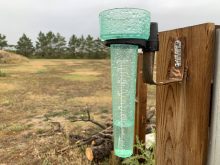The crop situation in British Columbia is dire as drought and fire continue to plague much of the province and rivers that provide irrigation are drying up, according to the executive director of B.C. Agriculture Council.
Danielle Synotte said the situation adds to existing problems caused by a strike by port workers on the West Coast, high input costs and food supply chain disruptions from the war in Ukraine.
“There are plenty of challenges that producers are facing but, right now, of course the wildfire and drought season are the biggest pressure points at this time,” she said.
Read Also

Feds propose overhaul of chronic wasting disease control program
Chronic Wasting disease control program getting updated by Canadian Food Inspection Agency with feedback encouraged from producers.
The low river levels are a particular problem, she said. The provincial government is expected to issue fish protection orders to allow salmon to navigate what little water there is, and that could stop all irrigation.
Synotte said when fish protection orders come out, “taps are switched off for everyone and it can be devastating for farmers.
“Producers understand the importance of protecting fish populations. This is why we all have to do our part in limiting non-essential water use this summer.”
It will also affect vegetable, forage and feed corn production.
Producers are doing their part, she said, by scheduling irrigation use to stagger the draw on rivers and are growing crops that require less water.
The conditions are blamed on a low mountain snowpack, lack of precipitation and an early spring melt.
“As a result of that, there is nothing more coming,” said Synotte.
Hay production is especially hard hit in the province, with Synotte estimating it to be 50 to 75 percent of average.
While the low river levels are affecting southern B.C. farmers, the Peace Country in the northeast is experiencing early season fires and dry conditions.
“They are dealing with (fires), a lot of smoke, which impacts crops, of course, and then they’ve been in discussions also with the province and cattlemen’s association in regards to feed,” said Synotte.
She hopes producers will be able to harvest drought-damaged crops early and direct them to feed markets, instead of harvesting the crops later for food.
Nearly the entire province’s crop production areas are listed as having the highest or second highest drought level, according to the latest information from the B.C. government.
“It’s definitely taxing on our producers. It kind of feels like death by a thousand cuts almost at times,” said Synotte.
Between the drought and floods over the past few years, she said she fears agriculture may not be an attractive proposition to younger farmers wanting to enter the business to replace those who are retiring, noting the average age of a B.C. farmer is 58.
“To invest in what it costs to rebuild after disaster strikes — AgriRecovery and AgriStability are great, but it doesn’t make them whole necessarily. They’re still out of pocket for a lot of things,” she said.
That, on top of continued risk of disaster and rising insurance costs, could discourage growth or even increase the number of those leaving the business, she said.
There is a bright spot in agricultural production in the province, according to Peter Simonsen, B.C. Fruit Growers Association president, as this year’s crops are looking good.
Simonsen said while there is a drought, Okanagan fruit growers have built resiliencies against the notoriously hot climate, which have insulated its crops from the worst of this year’s conditions.
The recent fires in Osoyoos, near the United States border, affected some fruit producers because of evacuations but Simonsen said crews have been quick to prevent damage to groves and orchards.
But the industry hasn’t escaped all the pitfalls.
“Costs keep going up,” he said. “Farming is getting harder every year. We don’t have enough young people in the business, we have marketing issues as the retail structure in Canada seems very concentrated and not supportive enough of locally grown produce.”
Simonsen said some producers are selling cherries wholesale for as little as $1 per pound but seeing them retail for $5.
“This is not up for debate, this is truly happening,” he said.
B.C. has applied to the federal government for AgriRecovery funding, though as of Aug. 14, a decision on moving forward with an assessment had not been made.
More than 400 wildfires are currently burning in the province.
















